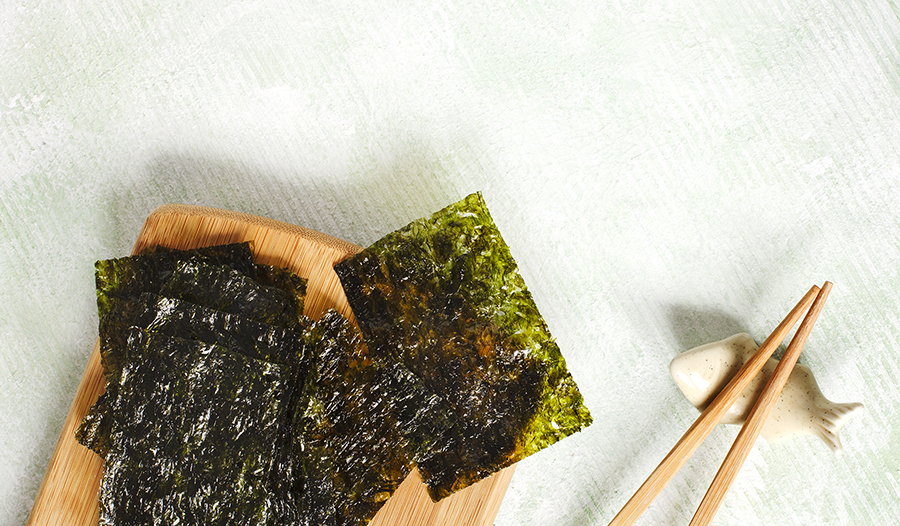Девять полезных свойств морской капусты

Морские водоросли (морская капуста) издавна собираются и употребляются в пищу населением прибрежных морских районов по всему миру. Лидером по употреблению морских водорослей является Япония — здесь оно составляет более пяти грамм в день на душу населения. За последние несколько лет наблюдается резкий рост популярности морских водорослей во многих странах. Сушеные хрустящие морские водоросли стали распространенной закуской. Кроме того, их стали часто использовать в продуктах для ухода за телом.
Морские водоросли получают энергию путем фотосинтеза, когда глюкоза вырабатывается под воздействием солнечного света. Невозможно переоценить вклад водорослей и фитопланктона в атмосферу. Считается, что 90% всего атмосферного кислорода поступает из моря.1 Водоросли могут быть полезны и для нашего организма.
Три вида морских водорослей
В целом, морские водоросли (макроводоросли) можно разделить на три группы:
- Красные водоросли (Rhodophyta) — обычно обитают на глубине 30 метров. В чистой воде могут расти и глубже. К ним относятся нори и темно-красная водоросль.
- Зеленые водоросли (Chlorophyta) — обычно растут на мелководье. К ним относятся хлорелла и спирулина («сине-зелёные водоросли»).
- Бурые водоросли (Phaeophyceae) — растут на глубине от 5 от 30 метров. Эта группа включает ламинарий, вакаме и морскую капусту.
Отличный источник витаминов и минералов
Морские водоросли богаты витаминами B1, B2, B12 и C. Большинство их видов также содержат много бета-каротина, витамина A и витамина E. Кроме того, они содержат до 10 раз больше минералов, чем наземные растения схожего размера. Морские водоросли наиболее богаты йодом, кальцием, магнием, железом, калием и натрием.
Это низкокалорийный продукт, богатый питательными веществами. Морские водоросли содержат лектины, пептиды, аминокислоты, полифенолы (антиоксиданты) и полисахариды. В их составе есть и сахарные спирты. Так, красные водоросли содержат сорбит, а бурые — маннит.
Исследования показывают, что содержащиеся в морских водорослях белки имеют антиоксидантные свойства и могут помогать в снижении артериального давления, профилактике диабета и укреплении здоровья кишечника.2 Далее мы рассмотрим некоторые из этих исследований.
Влияют на артериальное давление
Высокое артериальное давление (артериальная гипертензия или гипертония) — частое заболевание, при котором сердце испытывает повышенную нагрузку из-за роста давления и сужения сосудов. Эта болезнь затрагивает сотни миллионов человек во всем мире: ею болеет каждый четвертый взрослый. Гипертония часто протекает бессимптомно, поэтому многие люди с повышенным артериальным давлением не знают о своем диагнозе. И поэтому ее часто называют «тихим убийцей». Эта болезнь сопряжена с повышенным риском инфаркта, инсульта, сердечной недостаточности и болезни почек, особенно если ее не лечить.
Для снижения давления часто используются лекарства. Кто-то же ищет другие, альтернативные способы.
В исследовании 2002 года3 оценивалось влияние хлореллы (зеленых водорослей) на артериальное давление. Авторы отметили, что у некоторых участников с гипертонией малой или средней тяжести хлорелла по сравнению с плацебо помогла снизить артериальное давление или как минимум сохранить его на стабильном уровне.
В исследовании 2009 года4 также изучалось общее влияние морской капусты на метаболический синдром, в частности, на артериальное давление. Авторы пришли к следующему выводу: «Употребление 4-6 грамм морских водорослей в день, характерное для большинства населения Японии, может быть связано с меньшей распространенностью метаболического синдрома».
Наконец, в исследовании 2011 года5 отмечено, что японские дети, употребляющие больше морской капусты, имеют более низкое диастолическое давление. Кроме того, в опубликованном в 2020 году исследовании6 морских водорослей нори в Японии сказано, что «употребление нори ведет к снижению уровня диастолического артериального давления у мальчиков. Употребление морской капусты может иметь профилактический эффект против повышения артериального давления в детстве».
Могут помочь контролировать уровень сахара в крови
Более 422 миллионов человек во всем мире страдают от диабета. Подавляющее их большинство (90-95%) имеют диабет 2-го типа — заболевание, в первую очередь обусловленное образом жизни, в частности, употреблением большого количества сахара и малой подвижностью. Диабет 1-го типа невозможно предотвратить — он развивается, когда иммунная система атакует поджелудочную железу, подавляя выработку инсулина. Питание и образ жизни значительно влияют на вероятность развития диабета 2-го типа. По данным исследований, морские водоросли могут быть здесь полезны.
Опубликованное в 2014 году исследование7 бурых водорослей вакаме показало, что они могут понизить уровень сахара в крови при употреблении вместе с белым рисом.
В исследовании 2015 года отмечено, что хлорелла может быть полезна при диабете. Авторы обнаружили, что употребление зеленых водорослей может быть полезно для профилактики развития диабета.
Положительный эффект был отмечен в исследовании 2019 года8 на мышах с диабетом. Ученые обнаружили, что все виды морских водорослей ослабили диабет и улучшили уровень холестерина по сравнению с контрольной группой.
В исследовании 2019 года9 показано, что при употреблении вакаме наблюдалось снижение уровня глюкозы в крови. В другом исследовании10 того же года изучалось употребление хлореллы больными диабетом крысами. В итоге было отмечено, что хлорелла и физическая активность могут улучшить уровень сахара в крови.
Могут ослаблять симптомы артрита
Артрит — болезнь, с древности преследующая людей. Не следует полагать, что до развития современной фармацевтики больные артритом смирялись перед постоянными страданиями. Напротив, они использовали растения и органические продукты для ослабления связанной с артритом боли.
Слово «артрит» образовано от греческого «ἄρθρον» (сустав) и латинского «itis» (воспаление). Есть два основных типа артрита. Первый — остеоартрит. На него приходится около 95% случаев заболеваний, и он вызван возрастным разрушением суставов, чаще всего коленных и бедренных. Второй — ревматоидный артрит (~5%). Он связан с аутоиммунным заболеванием и может случиться в любом возрасте.
В исследовании 2008 года11 изучалось влияние минерального комплекса из красных морских водорослей (Aquamin) на больных артритом коленей. В итоге были отмечены уменьшение боли и повышение подвижности при приеме в течение 12 недель. Исследование 2009 года12 показало схожие результаты. Авторы изучали полученное из морских водорослей вещество и его эффект при артрите коленного сустава. Они пришли к выводу, что Aquamin увеличивает амплитуду движений и дистанцию ходьбы у больных остеоартритом коленных суставов. Далее они отметили, что через 12 месяцев его приема возможно частично отказаться от НПВП (определенных противовоспалительных препаратов).
Богаты питательными веществами, полезными для кишечника
Пробиотики и пребиотики помогают укрепить здоровье кишечника. Морские водоросли богаты клетчаткой, которая способствует формированию здорового микробиома кишечника. Исследование 2019 года13 показало, что морская капуста имеет пребиотические свойства. Согласно исследованию 2016 года14, эти свойства в первую очередь обусловлены содержанием полисахаридов.
Могут помочь в профилактике катаракты
Помутнение хрусталика глаза со временем может привести к развитию катаракты. Если ее не лечить, все может закончиться потерей зрения. Ученые считают, что основной причиной помутнения хрусталика является его окисление. К факторам риска развития катаракты относятся сильное воздействие ультрафиолетового излучения, курение, диабет, высокое артериальное давление, прием определенных лекарств (например, пероральных кортикостероидов).
В исследовании хлореллы, опубликованном в 2003 году15, отмечается, что «...хлорелла имеет антиоксидантные свойства и может быть полезна в профилактике осложнений диабета, например, катаракты». Исследования 201316 и 2014 годов показывают, что активный ингредиент спирулины фикоцианин может предотвращать образование катаракт.
Помогают укреплять иммунитет
Здоровый иммунитет важен в защите от инфекционных заболеваний. Морская капуста могут быть для него полезны. Иммуноглобулин IgA — антитело, участвующее в защите слизистых оболочек (например, во рту и кишечнике) от инфекций.
В исследовании 2011 года17 отмечено, что употребление добавок на основе хлореллы в течение четырех недель помогает укрепить иммунитет у людей. Работа 2018 года18 описывает иммуномодулирующие свойства хлореллы, которые могут поддерживать желудочно-кишечный тракт в борьбе с микробами.
Могут помогать ослаблять симптомы фибромиалгии
Фибромиалгия (синдром фибромиалгии) — заболевание, характеризующееся развитием хронического болевого синдрома, выражающегося в мышечных болях, общих болях и усталости. Мышечные боли (миалгии) обычно являются диффузными, т. е. проявляются по всему телу. От этой болезни страдают примерно 10 миллионов человек в США и более 100 миллионов во всем мире. 90% больных — женщины. По данным исследований, 68% страдающих фибромиалгией пробовали пищевые добавки для облегчения симптомов. 19
Исследование 2000 года20 показало, что хлорелла может помочь при симптомах фибромиалгии. Однако, при этом автор отмечает, что необходимы дальнейшие исследования. В исследовании 2001 года опубликованы аналогичные результаты относительно хлореллы.
Источники:
- https://www.americanscientist.org/article/the-science-of-seaweed
- Admassu H, Gasmalla MAA, Yang R, Zhao W. Bioactive Peptides Derived from Seaweed Protein and Their Health Benefits: Antihypertensive, Antioxidant, and Antidiabetic Properties. J Food Sci. 2018;83(1):6‐16. doi:10.1111/1750-3841.14011
- Merchant RE, Andre CA, Sica DA. Nutritional supplementation with Chlorella pyrenoidosa for mild to moderate hypertension. J Med Food. 2002;5(3):141‐152. doi:10.1089/10966200260398170
- Teas J, Baldeón ME, Chiriboga DE, Davis JR, Sarriés AJ, Braverman LE. Could dietary seaweed reverse the metabolic syndrome?. Asia Pac J Clin Nutr. 2009;18(2):145‐154.
- Wada K, Nakamura K, Tamai Y, et al. Seaweed intake and blood pressure levels in healthy pre-school Japanese children. Nutr J. 2011;10:83. Published 2011 Aug 10. doi:10.1186/1475-2891-10-83
- Wada K, Tsuji M, Nakamura K, et al. Effect of dietary nori (dried laver) on blood pressure in young Japanese children: an intervention study [published online ahead of print, 2020 Mar 21]. J Epidemiol. 2020;10.2188/jea.JE20190176. doi:10.2188/jea.JE20190176
- Tanemura Y, Yamanaka-Okumura H, Sakuma M, Nii Y, Taketani Y, Takeda E. Effects of the intake of Undaria pinnatifida (Wakame) and its sporophylls (Mekabu) on postprandial glucose and insulin metabolism. J Med Invest. 2014;61(3-4):291‐297. doi:10.2152/jmi.61.291
- Sørensen LE, Jeppesen PB, Christiansen CB, Hermansen K, Gregersen S. Nordic Seaweed and Diabetes Prevention: Exploratory Studies in KK-Ay Mice. Nutrients. 2019;11(6):1435. Published 2019 Jun 25. doi:10.3390/nu11061435
- Yoshinaga K, Mitamura R. Effects of Undaria pinnatifida (Wakame) on Postprandial Glycemia and Insulin Levels in Humans: a Randomized Crossover Trial. Plant Foods Hum Nutr. 2019;74(4):461‐467. doi:10.1007/s11130-019-00763-5
- Horii N, Hasegawa N, Fujie S, et al. Effect of combination of chlorella intake and aerobic exercise training on glycemic control in type 2 diabetic rats. Nutrition. 2019;63-64:45‐50. doi:10.1016/j.nut.2019.01.008
- JL, Walsh M, Kuskowski MA, Zenk JL. A natural mineral supplement provides relief from knee osteoarthritis symptoms: a randomized controlled pilot trial. Nutr J. 2008;7:9. Published 2008 Feb 17. doi:10.1186/1475-2891-7-9
- Frestedt JL, Kuskowski MA, Zenk JL. A natural seaweed derived mineral supplement (Aquamin F) for knee osteoarthritis: a randomised, placebo controlled pilot study. Nutr J. 2009;8:7. Published 2009 Feb 2. doi:10.1186/1475-2891-8-7
- Chen HY, Huang TC, Lin LC, et al. Fucoidan Inhibits the Proliferation of Leiomyoma Cells and Decreases Extracellular Matrix-Associated Protein Expression. Cell Physiol Biochem. 2018;49(5):1970‐1986. doi:10.1159/000493660
- Cherry P, Yadav S, Strain CR, et al. Prebiotics from Seaweeds: An Ocean of Opportunity?. Mar Drugs. 2019;17(6):327. Published 2019 Jun 1. doi:10.3390/md17060327
- de Jesus Raposo MF, de Morais AM, de Morais RM. Emergent Sources of Prebiotics: Seaweeds and Microalgae. Mar Drugs. 2016;14(2):27. Published 2016 Jan 28. doi:10.3390/md14020027
- Shibata S, Natori Y, Nishihara T, et al. Antioxidant and anti-cataract effects of Chlorella on rats with streptozotocin-induced diabetes. J Nutr Sci Vitaminol (Tokyo). 2003;49(5):334‐339. doi:10.3177/jnsv.49.334
- Biol Trace Elem Res. 2013 Jan;151(1):59-67. doi: 10.1007/s12011-012-9526-2. Epub 2012 Oct 20.
- Otsuki T, Shimizu K, Iemitsu M, Kono I. Salivary secretory immunoglobulin A secretion increases after 4-weeks ingestion of chlorella-derived multicomponent supplement in humans: a randomized cross over study. Nutr J. 2011;10:91. Published 2011 Sep 9. doi:10.1186/1475-2891-10-91
- Chidley C, Davison G. The effect of Chlorella pyrenoidosa supplementation on immune responses to 2 days of intensified training. Eur J Nutr. 2018;57(7):2529‐2536. doi:10.1007/s00394-017-1525-9
- An internet survey of 2,596 people with fibromyalgia. Bennett RM, Jones J, Turk DC, Russell IJ, Matallana L. BMC Musculoskelet Disord. 2007 Mar 9; 8():27.
- The results of this pilot study suggest that dietary Chlorella supplementation may help relieve the symptoms of fibromyalgia in some patients and that a larger, more comprehensive double-blind, placebo-controlled clinical trial in these patients is warranted.
- Merchant RE, Andre CA. A review of recent clinical trials of the nutritional supplement Chlorella pyrenoidosa in the treatment of fibromyalgia, hypertension, and ulcerative colitis. Altern Ther Health Med. 2001;7(3):79‐91.
ОТКАЗ ОТ ОТВЕТСТВЕННОСТИ:Информация, содержащаяся в Центре здоровья, не предназначена для постановки диагноза...













































































 Содержание
Содержание


